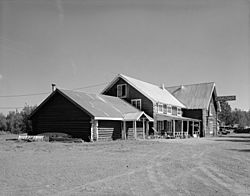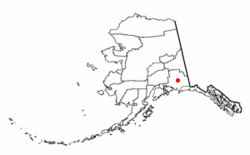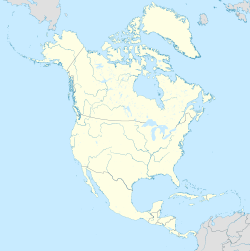Gakona, Alaska facts for kids
Quick facts for kids
Gakona
Ggax Kuna’
|
|
|---|---|

Side view of the Gakona Roadhouse, a major community building
|
|

Location of Gakona, Alaska
|
|
| Country | |
| State | |
| Census Area | Copper River |
| Area | |
| • Total | 60.64 sq mi (157.06 km2) |
| • Land | 60.63 sq mi (157.03 km2) |
| • Water | 0.01 sq mi (0.03 km2) |
| Population
(2020)
|
|
| • Total | 169 |
| • Density | 2.79/sq mi (1.08/km2) |
| Time zone | UTC-9 (Alaska (AKST)) |
| • Summer (DST) | UTC-8 (AKDT) |
| ZIP code |
99586
|
| Area code(s) | 907 |
| FIPS code | 02-27420 |
Gakona is a small community in the state of Alaska, in the United States. Its name, Ggax Kuna’, comes from the Ahtna language. Gakona is a "census-designated place" (CDP), which means it's a special area used for counting people by the government.
As of 2020, about 169 people live in Gakona. It is also home to a very interesting research program called the High-frequency Active Auroral Research Program (HAARP).
Contents
Where is Gakona?
Gakona is located in the middle of the Copper Valley in Alaska. It is surrounded by mountains and sits near the Copper River. The community is found where the Copper River meets the Gakona River.
It's about 15 miles (24 km) northeast of Glennallen. Gakona is also close to two important roads: the Tok Cut-Off and the Richardson Highway.
Gakona's Climate
Gakona has a "continental climate." This means it has very long and cold winters. Summers in Gakona are usually warm. On average, Gakona gets about 61 inches (155 cm) of snow each year. The total rainfall is around 13 inches (330 mm) per year.
The total land area of Gakona is about 61.3 square miles (158.8 square kilometers).
A Look at Gakona's History and Culture
The Ahtna Athabascans have lived in the Copper River basin for a very long time, possibly for 5,000 to 7,000 years. Gakona started as a place where people would gather wood and fish. Over time, it grew into a permanent village. Today, the Native Village of Gakona is a federally recognized tribe located in the community.
Historic Buildings
In 1904, a building called Doyle's Roadhouse was built. It was located at a busy crossroads for travelers. This roadhouse became a very important stop for people traveling through Alaska. It also had a post office, a station for stagecoaches, and a blacksmith shop. Some of these old buildings are still standing today.
The Gakona Lodge was built later, in 1929. It was run by Henra Sundt for many years. The lodge is now listed on the National Register of Historical Places. It has rooms, cabins, a restaurant, and a tavern. Today, it is a popular spot for people who enjoy fishing, especially for king and sockeye salmon.
Who Lives in Gakona?
Gakona first appeared in the U.S. Census in 1940. In 1980, it became a census-designated place (CDP).
| Historical population | |||
|---|---|---|---|
| Census | Pop. | %± | |
| 1940 | 46 | — | |
| 1950 | 50 | 8.7% | |
| 1960 | 33 | −34.0% | |
| 1970 | 88 | 166.7% | |
| 1980 | 87 | −1.1% | |
| 1990 | 25 | −71.3% | |
| 2000 | 215 | 760.0% | |
| 2010 | 218 | 1.4% | |
| 2020 | 169 | −22.5% | |
| U.S. Decennial Census | |||
In 2000, there were 215 people living in Gakona. About 75% of the people were White, and about 12% were Native American. Around 10% of the population was made up of people from two or more races.
The average age of people in Gakona in 2000 was 41 years old. About 28% of the population was under 18 years old.
Community Services in Gakona
Gakona has a trading post where you can buy groceries, some hardware, local clothing, and fishing gear. Fishing for salmon and river rafting are popular fun activities here.
Utilities and Healthcare
Most homes in Gakona have their own wells for water and septic systems for waste. The local school also has its own water system. Electricity is provided by Copper Valley Electric Assoc.
For healthcare, there is the Gakona Health Clinic. A larger medical center, the Cross Road Medical Center, is about 30 miles (48 km) away in Glennallen. Gakona is considered an "isolated village" but has access to emergency services. These services include 911 telephone service and volunteers.
Education
The Copper River School District used to run the Gakona Elementary School. From 2003 to 2008, about 15 to 17 students attended the school. However, the school closed in 2008 and was still not open in the 2017/2018 school year.
Gakona's Economy and Travel
Gakona's economy relies on local businesses and tourists who visit during certain times of the year. The historic Gakona Lodge and Trading Post is a key business, offering rooms, a restaurant, cabins, and a tavern. There is also a sawmill and a dog sled maker in Gakona.
Outdoor Activities and Research
During the summer, many people work as guides for fishing and hunting trips. They also help with rafting tours. Gakona is known for its excellent fishing, especially for King Salmon, Sockeye Salmon, and Rainbow Trout, because it's located near the Copper, Gakona, and Gulkana Rivers. Some residents also rely on traditional activities like trapping and hunting for food.
Near Gakona, there is special recording equipment for the High Frequency Active Auroral Research Program (HAARP). This program studies the Earth's upper atmosphere.
Getting Around
The Glenn Highway/Tok Cut-Off and Richardson Highway connect Gakona to larger cities like Anchorage and Fairbanks. There is also a paved runway nearby in Gulkana for airplanes.
Images for kids
See also
 In Spanish: Gakona para niños
In Spanish: Gakona para niños





